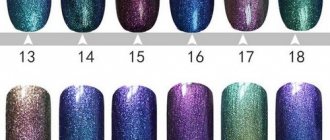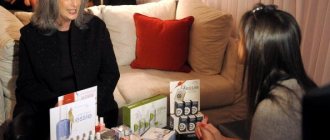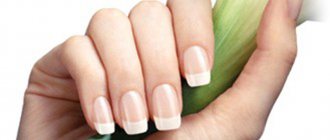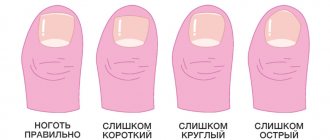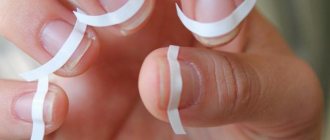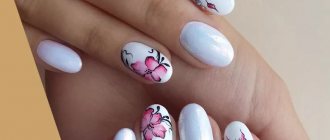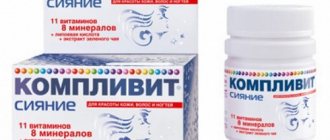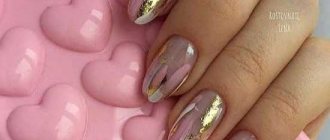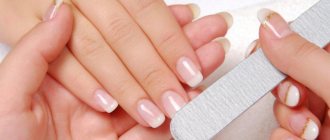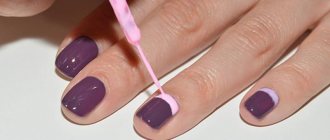Just like fashion, nail trends come and go. Michelle Humphrey, a phenomenal nail artist who works with celebrities, shared some of her favorite designs for 2022. If you're feeling adventurous with bright colors, you're in luck. These are some of the most popular options for spring. If you're not into all the bright colors, Humphrey recommends trying a muted yellow like mustard.
Even though bold nails are trendy in 2019, clear nails can be just as creative, especially if you opt for glossy clear nail extensions. In addition to choosing the perfect color, there are other options for creating artificial nails. You can choose your ideal shape and choose the material yourself. But dip powder is becoming increasingly popular. In this article we will tell you everything you need to know.
Acrylic based
Artificial nails, no matter what type you choose, have a common base.
“All of the ingredients used to create any type of artificial nail—whether it's bonded, UV-cured, or mixed with liquid and powder—are based on the acrylic family of paints,” says master artist Doug Schoon.
Delicious oatmeal and honey pie: a great dessert recipe without sugar and flour
How to make a bright vertical flower bed for a summer cottage: master class
The prototype of the European constitution appeared in Rome: where did the common people go?
Once popular, acrylic nails are made by combining liquid and powder to create a gel-like substance. “Gel” manicure is actually very similar. Once hardened, the nails are placed under ultraviolet light for at least a few minutes.
The modern method may seem revolutionary, but only at first glance. In fact, it is not much different from other types. The technique gets its name from the fact that after applying the binder, the nails are dipped in a colored powder of your choice and covered with a sealing top coat.
"Lightweight acrylic"
While powder-based manicures are still acrylic, celebrity manicurist Erika Marton told Glamor that the method is more like "acrylic lite." It turns out to be an intermediate version of the usual colored manicure and artificial nails. You might think that this makes the powder method more attractive than a traditional acrylic manicure. Theoretically, this is possible, but unfortunately it is not true.
Ariel Zuniga of Vanity Projects nail salon in New York City disagrees with the use of glue in powder manicures. According to her, this is a very cheap product, often containing harmful substances that are dangerous for natural nails. You should especially be wary of methyl methacrylate, which is already banned in some countries.
Neon French: a spring manicure that can be done without going to the salon
What natural sounds should you listen to to lift your mood and relieve stress?
Hormonal balance is fine: scientists explained the healing power of hugs
Reader's Digest suggests asking your nail technician about the ingredients in the products they use before getting a manicure. Methyl methacrylate can be identified by its characteristic chemical odor. It's very spicy and fruity.
If you visit a reputable salon, you likely won't have to worry too much about methyl methacrylate being used in powder manicures. However, it may surprise you to know that the legal binder used for dipping is cyanoacrylate. Essentially, this is a technology known as Krazy Glue.
Powder for gel polish is an excellent strengthening agent.
Despite the relative novelty of the method that allows you to use powder for gel polish as a strengthening agent, many women and girls successfully use it to combat imperfections in the nail plates. You can see what this product looks like in the photo.
What is acrylic powder for gel polish? It is a fine-grained synthetic polymer material with excellent thermoplastic properties. For its production, acrylic acid is used, which can significantly strengthen any type of material that it covers. This material allows you to create the most interesting and unique nail designs of various lengths.
Popular technology
While powder manicures may seem like a new trend, they have actually been around for quite some time. Owner and nail technician Denise Gottschalk said she first learned about the technique in 1997. While on vacation, she went to a nearby salon where a technician sold her a powder manicure.
It is believed that dip-in systems will eventually take over conventional nail painting, as this technique is much easier to apply than acrylic or gel nails.
The technique of teaching this method is not at all complicated, it is much simpler than with most other options.
Prayer that is read at home on Parents' Saturday if they cannot go to church
40 years of the Leningrad rock club: memories of Garkusha, Kinchev and others
Lenten dessert without flour: semolina pie turns out so good you'll lick your fingers
Time to create a manicure
Dipping powder wins over other manicure methods when it comes to how long the procedure itself takes.
Dipping powder does not require UV or LED light and typically takes much less time from start to finish than any other method. The main thing is that you don’t have to wait for your nails to dry. But this is the most boring and tedious part of any gel or acrylic manicure.
Speed of application was the main thing that interested nail salon owner Denise Gottschalk from the very beginning.
“I was fascinated by the fact that the whole procedure took 30 minutes,” Gottschalk said of her first experience with the original immersion system. The simplicity and speed of application, combined with their funny name, attracts more and more customers every year.
What is mirror powder
Mirror powder for nails, otherwise called rubbing, is a fine shiny dust made from aluminum. It is capable of giving nails a mirror-metallic or, as they sometimes say, “chrome” shine.
Available in many different shades from classic metallic gray to red, green, gold and even black. One of the advantages of mirror powder is a fairly simple mechanism for applying it, which can be handled even by a beginner who does not have much experience in applying manicure.
Other benefits of mirror powder include:
- high degree of convenience; any type of such manicure can be easily done at home;
- the rub can be easily removed from the nails if you don’t like it;
- with its help, not only a metallic, but also a shimmering effect is achieved;
- a large fraction of mirror powder will help create a voluminous nail design;
- it is fashionable to apply it to a French manicure, since this combination allows you to create both one and two zones on the nail with different shades of the mirror surface;
- when creating voluminous patterns on nails with gel polish, the effect of mirror powder will be simply fantastic;
- is a very inexpensive, but at the same time, effective solution;
- the durability of mirror powder applied to gel polish lasts up to three weeks;
- it attaches well and reliably to the surface of the nail;
- since in the vast majority of cases such powder is applied to gel polish, it is completely harmless to the body;
- Given the variety of shades, you can choose the color of mirror powder to match any outfit or makeup.
Nail art experts recommend choosing the right color combination of gel polish and mirror powder so that they match each other.
You may also be interested in information on how to properly use impress solid nail polish.
One of the varieties is the so-called “prism rubbing”. Its main difference is the smaller fraction, which allows you to create real three-dimensional effects. Sometimes it is mistakenly called a “hologram”, but this is not so, since the size of the holographic rubbing fraction is somewhat larger, its particles can even be distinguished with the naked eye.
The prism allows you to create spectral tints on your nails, giving your nails the appearance of a natural rainbow. In addition, when using some colors of gel polish, you can achieve a mother-of-pearl effect on your nails.
It is believed that rubbing prism gives nails a more sophisticated and expensive look.
But what thermal nail polishes look like in the photo and how to use them will help you understand the information in the link.
The video shows all the features of using mirror powder:
You don't have to worry about skin cancer
Another plus is that there is no need to expose your hands to ultraviolet light. This not only saves time at the nail salon, but also eliminates the risk of skin cancer.
We clean wooden floors and furniture from oil stains: use home remedies
Better than other sisters: by highlighting a favorite, a father fosters success in children
The young wife of Valery Syutkin: what does she do
Of course, the likelihood of getting skin cancer from UV lamps used in nail salons is relatively low. However, one study found that the lamps cause enough damage to skin cells to cause skin cancer. Especially if you get involved in this procedure very often.
You don't actually have to dip your nails in powder.
The fact that with a powder manicure you have to dive is actually not the most accurate and successful word. In fact, you'll never have to dip your nails in a jar of dip powder at the salon.
It would be too serious a violation of sanitary regulations if several clients were to dip their nails into the same container of powder. Even pouring product onto the nails of multiple clients and then allowing the powder to fall back into the container is a way to transmit nail infections.
Therefore, if nail technicians use dip powder using any of these methods, you should leave immediately and go to another salon.
Strengthening with acrylic powder under gel polish step by step
Strengthening with acrylic powder under gel polish looks like this step by step:
- Perform a hygienic manicure.
- Nails are treated with a buff, wiped with a degreaser, and coated with primer.
- Apply the base product.
- Powder is poured onto the damp surface of the nail.
- Shake off excess.
- Dry in a lamp.
- Go over the nail with a brush.
- Cover it with another layer of base or gel polish.
- The composition is polymerized.
- Use the finishing coat and dry it.
Preparation
The first stage is disinfecting hands and nails and preparing them for the use of artificial materials. Spray an antiseptic on the skin and rub it over the surface. The nails are given the desired shape and the same length using a file. The keratinized part of the cuticle is cut off, the pterygium is cleaned, including from the area of the lateral ridges. The gloss is removed from surfaces with a buff. And then they and the skin nearby are wiped with a degreaser, carefully removing all dust and lint.
The cleanliness of the manicure is very important; it will ensure the absence of streaks, and later peeling, and an even, high-quality coating of materials.
Using a Primer
After degreasing the nails, a primer is applied to them, combined with acrylic material. It can be acidic or acid-free; there are liquids labeled Acrylic. For many, the coating also lasts on a weaker ultrabond with a low content of aggressive chemicals. The main thing is to apply the chosen product correctly:
- in a small amount, but on the entire plate and end;
- without affecting the skin;
- then dry it in air for 1-2 minutes, if the instructions for the composition do not indicate to polymerize it in a lamp.
Applying the base
For acrylic powder, choose a plastic base, that is, rubber. It should be of medium consistency and smooth out well. The product is applied in a thin layer, not reaching 1-1.5 mm to the cuticle. There is no need to level the base at this stage, nor do you need to dry it. If the product gets on the skin, it should be removed immediately with a cloth moistened with a degreaser or an orange stick.
Using powder
The powder can be applied to the nail in two ways:
- dipping your finger into a jar of it several times;
- sprinkle the plate with powder from a spatula.
In both cases, the finger should remain in one position - down, so that the undried base does not flow onto the cuticle, and the powder lies more evenly. You need to wait some time for it to mix on the nail with the liquid. The remains are shaken off by tapping the applicator on your finger. Then you can put your hand in the drying lamp. The process time is standard, depending on the type of device.
You should not apply powder under the cuticle or even to its very edge. After all, the base of the nail remains static even without acrylic composition; only the central part and the free edge should be strengthened. There is also no need to be afraid that unevenness will form at the border if the base is used in moderation.
Applying a second layer of base or gel polish
The powder must be fixed with the next layer of polymerizing material. Before applying it, brush the dried nail with a brush to remove excess grains. Then you can use your choice:
- another layer of base if the powder was decorative;
- gel polish
The base is applied with leveling, but the layer needed is quite thin. It should be dried in a lamp. Gel polish is usually used to paint nails twice, polymerizing each time. The final coating in any case is top. It is dried in a lamp.
You shouldn't do this manicure yourself.
At this point, many may think that the surest way to avoid catching any infection in a beauty salon is to buy dip powder for yourself while performing the procedure yourself at home. In this case, you really won’t get infected, but still doing such a manicure yourself is not a good idea.
Fashion industry professionals never recommend doing your own gel or powder manicure because both treatments have chemical products that can harm the skin or nail bed if not applied properly.
Even professional-grade formulations and products sold for home use contain harmful chemicals, so it's safer to go to a salon where a professional will treat you.
Manicure tools with acrylic powder and gel polish
Manicure with acrylic powder and gel polish is performed using:
- antiseptic liquid,
- files;
- buff;
- hand brushes;
- cuticle scissors or nippers;
- an orange stick or an applicator with a silicone tip, a pusher;
- remover;
- degreaser (dehydrator);
- lint-free wipes;
- primer;
- bases;
- gel polish;
- finishing agent;
- lamps for coating polymerization.
If you have a manicure machine, some of the tools may not be needed.
How long does this manicure last?
One of the distinctive features of this manicure is durability. Nail specialist Elaine Lin Lee, who works at Valley Salon in New York City, confirms that this is truly an incredibly long-lasting manicure. It lasts up to two months.
Such a period may seem incredible to many, but it is true. However, most experts do not recommend wearing it for so long so as not to damage natural nails. After all, they also need rest.
Now that you know a lot about dip powder for manicure, you can make your own decision and figure out whether you need such a procedure in a beauty salon or whether you would prefer to opt for the more familiar and familiar acrylic or varnish.
Found a violation? Report content
